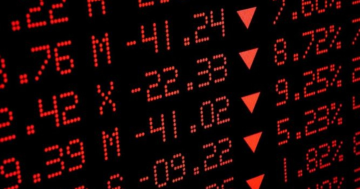Bryna Howes* explains what dividend investing is and how to tell if it’s for you.
 A dividend is a distribution of a company’s profits. Usually, ASX-listed companies will pay dividends twice a year — an “interim” dividend, followed by a “final” dividend.
A dividend is a distribution of a company’s profits. Usually, ASX-listed companies will pay dividends twice a year — an “interim” dividend, followed by a “final” dividend.
Companies in the US typically pay quarterly, others pay one-off dividends, and some not at all.
Now you know what a dividend is, let’s get onto the question at hand: what is dividend investing? Dividend investing is an investment approach whereby you specifically purchase stocks that issue dividends for the purposes of generating a stream of passive income.
- What type of companies issue dividends?
- What might you look for in a company that pays dividends?
- Why might I want dividends as a passive income stream?
- What are some other ways to use dividends?
Let’s get into the nitty-gritty.
Some companies like to “reward” their shareholders by divvying up their profits and paying each shareholder a percentage of those profits that is proportional to the amount of stock they own.
Say you’re a shareholder in Woolworths.
Woolworths pays its shareholders a fully franked dividend twice a year.
In September 2018, the dividend Woolworths paid was 50 cents per share, as well as a special dividend of 10c.
More recently, in May 2019, the dividend was 45 cents per share.
For this reason, if you were thinking of getting into dividend investing, Woolworths might be one share you’d consider buying stock in.
(Of course, you should always do your research and weigh the pros and cons before buying stock in any company because investment returns, including dividends, can go up and down, and can sometimes be zero.)
What type of companies issue dividends?
As you might have figured by now, not every company pays dividends.
Usually, you’ll find that the types of companies that pay dividends have been around for a while and feel they have a pretty strong position in their market.
Dividend-paying companies tend to be slower growth companies.
They are not reinvesting all of their profits for growth investments; instead they use some or all of the profits to pay out dividends.
On the flip side, a company that is trying to scale its business usually won’t pay dividends.
This is because it wants to reinvest its profits back into the company and use the money to propel its growth.
Sometimes, even a seasoned company will choose to reinvest its earnings — maybe because they want to use their profits to expand or acquire a new asset.
As an investor, you just need to decide what you want.
Non-dividend companies are typically more aggressive and volatile because they are trying to grow.
Take, for instance, Amazon.
Amazon has never issued a dividend but has experienced significant share price growth over the years.
For some companies, it’s all part of their overall plan.
What might you look for in a company that pays dividends?
Okay, so you’re ready to get into dividend investing, which means it’s time to figure out which companies to invest in and which ones to avoid.
Payout ratio
One of the first things you should take into consideration is the company’s payout ratio.
For example, if the company reports $50 million in profits and pays $45 million in dividends, you might ask yourself how stable that company would be if disaster strikes.
If 90 per cent of profits are going to the dividend, what happens if profits decline? The dividend will be at risk.
If your research leads you to believe they are, you might want to avoid that company.
Dividend yield
Dividend yield is essentially a ratio that measures the cash dividends against the stock price.
So, you’d probably consider the dividend yield when weighing up whether or not to buy stock in a company — especially if your plan is dividend investing.
The dividend yield changes daily, because while a dividend may be stable the share price can be volatile.
If a dividend stays the same, but the share price decreases, then the yield increases.
Of course, past performance isn’t a reliable indicator of future performance.
But you might want to include the past dividend yield in your research and that might give you a guideline to work with, at least.
Here’s how to work out the dividend yield in a company:
If you have 100 shares in Company X and Company X pays a five-cent dividend per share twice yearly, you receive $5 in dividend income twice a year (likely every six months).
To work out dividend yield, you will take the dividend price and divide it by the current share price.
You’ll then multiply that number by 100 to get the dividend yield.
For example, if Company X shares are worth $10, you’ll do the following:
Divide dividend price (five cents) / current share price ($100) x 100 = dividend yield.
Thus 0.05 / $10 x 100 = 0.5 per cent dividend yield.
Growth rate
When researching, growth rate is certainly something you’d want to consider.
What is growth rate exactly?
The growth rate measures how fast or slow the company’s dividends are growing over time.
For example, maybe five years ago, Company Y was paying a two-cent dividend per share, but now it pays a five-cent dividend per share.
While you can’t determine now whether or not the dividend will continue to grow — past performance is no guarantee of future performance — you can use this as a guideline when undertaking your research.
Why might I want dividends as a passive income stream?
The basic idea behind dividend investing is to create a passive income stream — in other words, a stream of income that lets you sit back and watch the cash roll in.
With that said, participating in dividend investing comes with no guarantees.
In a bear market, for example, you might find that your dividend income is extremely volatile.
Keep in mind that companies can also stop issuing dividends and the growth rate can stall.
Therefore, there is an argument to be made that dividend investing isn’t a truly passive income stream.
Some maintenance is required.
While you can hope to sit back and generate extra cash for your savings, you may need to keep a watchful eye on your stocks.
What are some other ways to use dividends?
While dividend investing is the act of purchasing stocks that issue dividends for the purposes of generating a stream of passive (or not-so-passive) income, this isn’t the only option.
Some investors choose to reinvest their dividends back into the company.
In some cases, shareholders are even offered the choice to use their dividend to acquire additional shares in the company at a discount on the current market price.
Whatever you choose to do with your dividends — investing or reinvesting — you should always make sure you do your research and due diligence, and consider what suits your personal objectives, financial situation, and needs.
*Bryna Howes is the VP of Marketing & Brand at Spaceship.
This article first appeared at spaceship.com.au.











